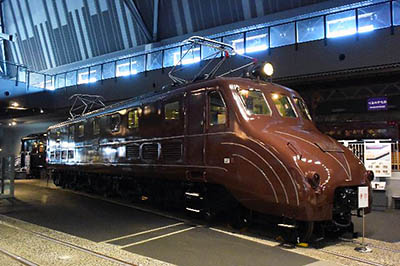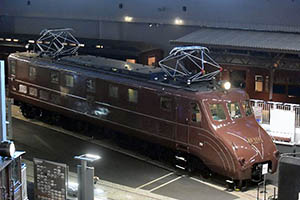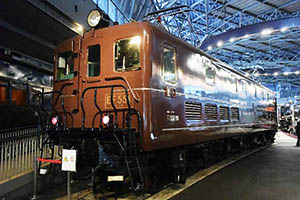
(Photo by N.Miyagawa)
Electric Locomotive
Class EF55 |
The first streamline DC electric locomotive. |
 (Photo by N.Miyagawa) |
During the 1930s, a streamline came into fashion in the world. The tendency emerged to rail vehicles also..... For example, the British LNER Silver Jubilee, a class A4 (Silver Link), Germany's Class 01.10, 03.10 appeared on the scene in Europe and the US. Asian railways were not an exception. For example, the South Manchuria Railway limited express "ASIA"s engine "PaShiNa-970", appeared during November 1934. In a similar way in Japan, steam loco's D51_22, D51_23 (1936), C53_43(1934), C55_20 to C55_40(1935-1936), Diesel car KiHa-42000 (1935), Electric car MoHa-52 (1936) etc, delivered a steady stream of new streamline models.
Three of the Japanese first streamline's electric locomotive class EF55 were born in such a background during March of 1936. EF55's electrical system was approximately similar and mass-produced as class EF53, but a gear ratio was changed for a high-speed ratio. Each EF55 was manufactured by the builders of Hitachi (No.1 SN:636), Nippon-Sharyo (No.2 SN:100) and Kawasaki Co. (No.3 SN:57). Consult please Class EF58 After an appearance, all EF55's were directed to the Numazu depot for the increased use of express trains between Tokyo and Numazu on the Tokaido line up to 1952. All EF55s were moved to the Takasaki line, Takasaki-2nd depot, with Takasaki line electrification during April of 1952, and worked between Ueno and Takasaki. But EF55's were needed for turning in the terminal the same as steam engines due to anterior-posterior asymmetry. They became hardly used on the main line service from 1957, because of their inconvenience. Decreased service appearances of the EF55s were because they were used for freight trains in the later years. During November 1962, EF55 No.3 was remodeled to the DC-AC prototype class ED30 No.1 at the Hamamatsu works. On that occasion of the remodeling, EF55_3's main motor and wheels were diverted to the ED30_1. ED30_1 was directed to the Maibara depot, and it was used for an examination of AC-DC relay tests between Maibara - Tamura on the Hokuriku line. Afterward, ED30_1 was moved to the JNR "Railway Technical Research Institute" in Kunitachi Tokyo during 1970, and it was retired and scrapped during July of 1976. EF55 No.1 and No.2 were deregistered during December 1964, and EF55_2 was scrapped during July of 1965. |
|
Preserved engine class EF55 No.1
After deregisteration, EF55 No.1 was moved to the JNR "Central Railway Campus" in Kunitachi Tokyo, and it was used as an instruction locomotive. But during May 1972, it was returned to the Takasaki-2nd depot. During the 14th of October 1978, it was designated a semi-Railway Monument. During 1986, EF55_1 was transferred to the Omiya works, and restoration work was started. Restoration was completed during the 24th of June 1986, and her registration was revived. EF55_1 was directed to the Takasaki depot, and saw service in an event train on the Jouetsu line Takasaki - Minakami. During January 2009, EF55_1 was retired from main line service due to it becoming older, and it was in safekeeping at the Takasaki Rolling Stock Center. During 2015, EF55_1 was again deregistered from JR-East, and it was moved to the Saitama Railway Museum. EF55_1 was exhibited at the Saitama Railway Museum from the 12th of April 2015. EF55 1 Before restoration, Takasaki-2nd depot, Nov 1972
After restoration, ex-Oku depot, Dec 2004 (Photo by N.Miyagawa)
|

| 
|
Introduction |
Go to Top |